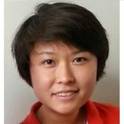
Advancements in additive manufacturing have made it possible to fabricate biologically relevant architectures from a wide variety of materials. Hydrogels have garnered increased attention for the fabrication of muscle tissue engineering constructs due to their resemblance to living tissue and ability to function as cell carriers. However, there is a lack of systematic approaches to screen bioinks based on their inherent properties, such as rheology, printability and cell viability. Furthermore, this study takes the critical first-step for connecting in-process sensor data with construct quality by studying the influence of printing parameters. Alginate-chitosan hydrogels were synthesized and subjected to a systematic rheological analysis. In situ print layer photography was utilized to identify the optimum printing parameters and also characterize the fabricated three-dimensional structures. Additionally, the scaffolds were seeded with C2C12 mouse myoblasts to test the suitability of the scaffolds for muscle tissue engineering. The results from the rheological analysis and print layer photography led to the development of a set of optimum processing conditions that produced a quality deposit while the cell viability tests indicated the suitability of the hydrogel for muscle tissue engineering applications.
Available at: http://works.bepress.com/sharon-lau/5/

This proceeding was published as Ramesh, Srikanthan; Sam Gerdes, Sharon Lau, Azadeh Mostafavi, Zhenyu (James) Kong, Blake N. Johnson, Ali Tamayol, Prahalada Rao, and Iris V. Rivero. "Rheological, In Situ Printability and Cell Viability Analysis of Hydrogels for Muscle Tissue Regeneration." Proceedings of the 29th Annual International Solid Freeform Fabrication Symposium: An Additive Manufacturing Conference. Austin, TX. August 13-15, 2018, pp. 835-846. Posted with permission.